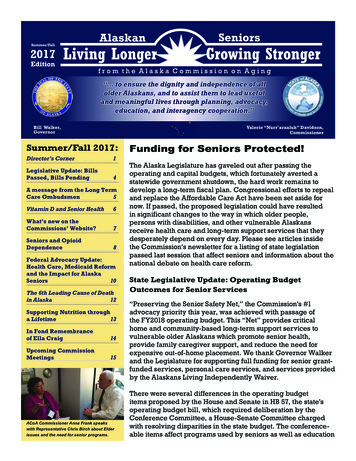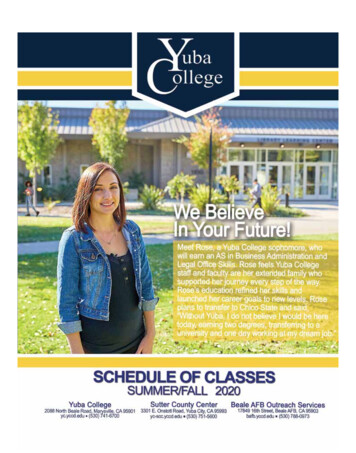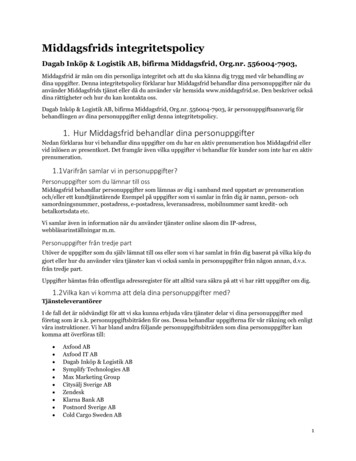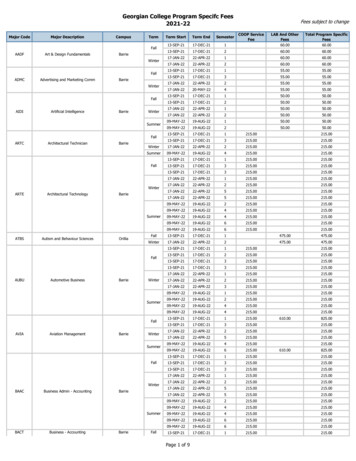
Transcription
Summer/Fall2017Edition“. to ensure the dignity and independence of allolder Alaskans, and to assist them to lead usefuland meaningful lives through planning, advocacy,education, and interagency cooperation.”Bill Walker,GovernorValerie “Nurr’araaluk” Davidson,CommissionerSummer/Fall 2017:Director’s Corner1Legislative Update: BillsPassed, Bills Pending4A message from the Long TermCare Ombudsmen5Vitamin D and Senior Health6What’s new on theCommissions’ Website?7Seniors and OpioidDependence 8Federal Advocacy Update:Health Care, Medicaid Reformand the Impact for AlaskaSeniors 10The 6th Leading Cause of Deathin Alaska 12Supporting Nutrition througha Lifetime13In Fond Remembranceof Ella Craig14Upcoming CommissionMeetings15ACoA Commissioner Anna Frank speakswith Representative Chris Birch about Elderissues and the need for senior programs.Funding for Seniors Protected!The Alaska Legislature has gaveled out after passing theoperating and capital budgets, which fortunately averted astatewide government shutdown, the hard work remains todevelop a long-term fiscal plan. Congressional efforts to repealand replace the Affordable Care Act have been set aside fornow. If passed, the proposed legislation could have resultedin significant changes to the way in which older people,persons with disabilities, and other vulnerable Alaskansreceive health care and long-term support services that theydesperately depend on every day. Please see articles insidethe Commission’s newsletter for a listing of state legislationpassed last session that affect seniors and information about thenational debate on health care reform.State Legislative Update: Operating BudgetOutcomes for Senior Services“Preserving the Senior Safety Net,” the Commission’s #1advocacy priority this year, was achieved with passage ofthe FY2018 operating budget. This “Net” provides criticalhome and community-based long-term support services tovulnerable older Alaskans which promote senior health,provide family caregiver support, and reduce the need forexpensive out-of-home placement. We thank Governor Walkerand the Legislature for supporting full funding for senior grantfunded services, personal care services, and services providedby the Alaskans Living Independently Waiver.There were several differences in the operating budgetitems proposed by the House and Senate in HB 57, the state’soperating budget bill, which required deliberation by theConference Committee, a House-Senate Committee chargedwith resolving disparities in the state budget. The conferenceable items affect programs used by seniors as well as education
(continued from page 1)and other basic services.The Conference Committeefor HB 57, co-chaired bySenator Lyman Hoffman andRepresentative Paul Seaton,also included RepresentativeNeal Foster, RepresentativeLance Pruitt, Senator AnnaMacKinnon, and SenatorDonald Olson.Funding for the AlaskaPioneer Homes was one ofthe most controversial seniorbudget items addressed bythe Conference Committee.The Pioneer Homes serve418 residents across its sixhomes with more than half ofthe residents receiving LevelIII, the highest level of care.Initially, the Senate proposedtwo reductions in two separateactions for the Pioneer Homes– 2.75% reduction ( 818,500)for personal services and a12.7% reduction ( 5.7 million)for the Pioneer Homes. Ifapproved, these reductionswhich totaled 6.5 millioncould have resulted in the lossof direct care staff, eliminationof beds, increased wait timefor people on the activewaitlist, as well as closure ofthe Palmer and Juneau Homes.These proposed reductionsresulted in a huge uproarfrom the senior community,including a community rallyorganized in the Mat-SuValley to show support for fullfunding of the Pioneer Homes(see photo below). The Senatepassed a declaration on theSenate floor titled the “Senseof the Senate” directing theDepartment of Health andSocial Services to spread thatamount across the departmentto avoid closing any PioneerHome.The Governor also senta letter assuring PioneerHome residents, their familymembers, and PioneerHome staff that no Homewould be closed under hisadministration. Fortunately,the Conference Committee,with approval from theLegislature and GovernorWalker, rescinded the 6.5million reduction slated forthe Pioneer Homes and theDepartment of Health andSocial Services in the finalbudget.The Conference Committeealso approved continuedfunding at current levels forMedicaid Adult PreventativeDental Services and MedicaidPrescription Drugs, programsused by many seniors. TheSenior Benefits Program,which provides cash benefitsto more than 11,000 seniorswho are income-eligible,has a 43,200 reduction forthe upcoming year however,this amount is considerablyless than the 5 million cutproposed last year.The FY2018 operating budgetalso includes reductions forpublic assistance and publichealth nursing that may affectseniors using these services.The Conference Committeeagreed to fully fund publicschools, grades K-12, atthe same level as this year,and to pay Permanent Funddividends in the amount of 1,100 to all eligible Alaskans.The total FY2018 stateoperating budget passed bythe Legislature, signed bythe Governor, is 9.6 billion,including all federal and statefunding sources, and willdraw an estimated 2.4 billiondraw from the ConstitutionalBudget Reserve.MatSu Community Rally for the Pioneer Homes held on April 15, 2017.Alaskan Seniors: Living Longer Growing Stronger2Alaska Commission on Aging
May is Older AmericansMonth in AlaskaMedicare appeals, amongother life achievements.Governor Walker signed theofficial Executive Proclamationrecognizing May 2017 as OlderAmericans Month in Alaska.The theme for this year is “AgeOut Loud” to focus attentionon what getting older lookslike today. More seniors areworking, striving to maintaingood health by eating healthyand exercising, as well asbeing active with their familiesand in their communities.Banarsi Lal was recognizedas the Outstanding SeniorVolunteer by the mayors of theFairbanks North Star Borough,City of Fairbanks, and the Cityof North Pole at the SeniorRecognition Day event onMay 4 that was hosted by theFairbanks North Star Borough(FNSB) Senior AdvisoryCommission with support fromthe FNSB Parks and RecreationDepartment. Mr. Lal, Chairfor the FNSB Senior AdvisoryCommission, currently serveson the statewide AlaskaCommission on Aging andthe Governor’s Council onDisabilities and SpecialEducation. He is the formerChair for the Alaska PioneerHomes Advisory Board. Mr.Lal holds an honorary doctorof law degree awarded bythe University of Alaska,Fairbanks.The Anchorage SeniorAdvisory Commission, theFairbanks North Star Borough,and the City of Palmercelebrated Older AmericansMonth (OAM) in Alaska duringthe first week of May througha Mayoral proclamationand activities honoringlocal seniors that included aspecial meal. On May 3, theAnchorage Senior AdvisoryCommission awardedAnchorage resident, KarenHunt, with the “Ron HammettAward” for distinguishedcommunity service thatincludes improving the qualityof life for seniors and otherpublic members. Ms. Hunt,who served on the Board ofDirectors for the AnchorageSenior Activities Center, wasalso the first woman fromAnchorage appointed to serveas a Superior Court Judge. Inaddition, Ms. Hunt served aspresident of four professionallaw organizations, as well asfaculty for the National JudicialCollege and trained more than200 judges hearing federalThe Mat-Su Valley alsohonored seniors as part ofOAM festivities. In the MatSu Valley, Palmer Mayor,Edna DeVries, read the Cityof Palmer Proclamation at thePalmer City Council meetingon May 9 and the Governor’sProclamation was read byACoA Commissioner andPalmer Council Member,Linda Combs, on May 10 atMat-Su Senior Services.Please take time to enjoy thebeauty and bounties of theseasons!Alaskan Seniors: Living Longer Growing Stronger3Karen Hunt received the 2017Ron Hammet Award at the OlderAmericans Month Kick Off EventCelebrating Seniors in Anchorageon May 3, 2017.Former ACoA CommissionerPaula Pawlowski is presentedwith a legislative citation by ACoACommissioner Mary Shields at theOlder Alaskans Month celebrationat the Anchorage Senior ActivitiesCenter on May 3.Thank you forcelebrating OlderAmericans Monthwith us!Alaska Commission on Aging
LegislativeUpdate: BillsPassed, BillsPendingSeveral important bills wereintroduced this session.“Extend the Alaska SeniorBenefits Program,” HB 236sponsored by RepresentativeScott Kawasaki (Fairbanks)and co-sponsored byRepresentatives Spohnholz,Fansler, Tuck and Ortiz,seeks to extend the programfour years to June 30, 2022.HB 236 has two committeereferrals in House Health andSocial Services and HouseFinance. The Senior BenefitsProgram is scheduled tosunset on June 30, 2018, ifcontinuing legislation is notpassed. Senior Benefits servesmore than 11,400 incomeeligible Alaskans age 65 .HB 236 was heard and heldin House Health and SocialServices this past session.The interim plan proposedby House Health and SocialServices will be to establisha legislative committee tooutreach to seniors, theirfamilies, providers, and otherpublic members to find waysto sustain and strengthen theSenior Benefits Program overtime.Other pending bills of interestinclude HB 123 “Disclosureof Health Care Costs,”sponsored by RepresentativeIvy Spohnholz (Anchorage), toimprove consumer awarenessabout the costs of commonhealth care services; HB106 “Civil Legal Services,”sponsored by RepresentativeZach Fansler (Bethel), toprovide a sustainable fundingsource for Alaska LegalServices that offers free andlow-cost civil legal assistancefor seniors, veterans, and lowincome Alaskans; and HB 186“Food Donations,” sponsoredby Representative Talerico(Healy), to remove the riskof liability for businesses todonate their excess unsoldfood items to charitableorganizations, like food banks,which also serve seniorcenters.Three bills were introducedand passed this legislativesession of interest to seniors.HB 16 “Driver’s LicenseRequirement, Disability, IDand Training,” sponsoredby Representative SteveThompson (Fairbanks) wassigned into law in order toincrease safety for people withimpairments not physicallyapparent (such as those havinghearing difficulties, memoryproblems, persons withintellectual and developmentaldisabilities, as well as personswho have a tendency towander) by providing trainingto peace officers to increasetheir ability to recognize theseimpairments and respondappropriately to these publicmembers in addition to otherbill provisions.“Fiduciary Access to DigitalAssets,” HB 108, sponsoredby Representative Claman(Anchorage), modernizesinheritance law by providing aAlaskan Seniors: Living Longer Growing Stronger4Governor Walker and ACoACommissioners Rachel Greenberg(left) and Linda Combs (right) meet inthe halls of the Capitol.means to manage and disposeof a principal’s digital assetsby their designated fiduciary.Digital assets include online financial transactions(Medicare, Social Security, andretirement benefits depositedelectronically), bank accounts,personal emails, Facebookaccounts and other personalitems. This legislation is ofimportance to seniors asmany are becoming on-lineusers. Reportedly, womenare the fastest growing agedemographic of Facebookusers between the ages of50 to 70 years old. GovernorWalker signed HB 108 into lawon August 2nd in Wasilla.“Protect Vulnerable Adults/Long-Term Care,” SB 83, aGovernor’s bill, was passedsigned into law on August 2ndin Anchorage. This legislationbrings Alaska’s statutes of theOffice of the Long-Term CareOmbudsman into alignmentwith federal changes from theAdministration on CommunityLiving. See more about thesechanges in the enclosed articlefrom the Office of the LongTerm Care Ombudsman.Alaska Commission on Aging
As Long Term CareOmbudsmen for Alaska,our mission is to meet withresidents of assisted livinghomes and nursing facilitiesto see if they have anyissues they need assistancein resolving. Establishedby the Older AmericansAct, the Long Term CareOmbudsman programis mandated to provideindependent oversight andadvocacy services to seniorsin Alaska’s long term carefacilities. The Long TermCare Ombudsman programis designed to protect therights, health, safety, andwelfare of Alaskans living inlong term care facilities. InAlaska, the Long Term CareOmbudsman program alsoprovides advocacy to seniorswith complaints about theirresidential circumstances.In 2016, the Older AmericansAct was reauthorized andnew regulations for LongTerm Care Ombudsmanwere created. As a result,the federal Administrationfor Community Livingreviewed all states toensure compliance withthese changes. Throughthis review, two Alaskastatues were identified asbeing out of alignment withthe reauthorized OlderAmericans Act and LongTerm Care Ombudsmanregulations. The Governorintroduced Senate bill 83 toamend provisions of Alaskastatute 47.62 Office of theLong Term Care Ombudsmanand 47.24 protection ofvulnerable adults to ensurealignment with the OlderAmericans Act and itsimplementing regulations.Currently, SB 83 is awaitingsignature by the Governorafter passing the House andSenate. Briefly, this bill: Aligns state statuteswith federal statutes andregulations to ensureOffice of the Long TermCare Ombudsmanonly shares residentinformation with informedconsent and to ensureOffice of the Long TermCare Ombudsmancan obtain records toinvestigate and makereferrals when residentis unable to provideinformed consent.Alaskan Seniors: Living Longer Growing Stronger5 Removes (due to aconflict of interest) theoption for mandatoryreporters to meetreporting requirementsby submitting report tothe Office of the LongTerm Care Ombudsman. Clarifies the separation ofthe role of the Long TermCare Ombudsman fromthe role of Departmentof Health and SocialServices (Adult ProtectiveServices and long termcare licensing). Clarifies that Office ofthe Long Term CareOmbudsman mayserve residents in longterm care facilitiesunder the age of 60.All the changes in SB 83 willhelp the Long term CareOmbudsmen do their jobmore efficiently and moreeffectively. If you have 3 hoursa month to share with an elderAlaskan, we would love tohave you volunteer for ourprogram. Call Kathryn Curryat 334-2535 or apply online athttp://akoltco.org/volunteer/.Alaska Commission on Aging
“Older adults in particular are at increased risk forvitamin D deficiency for several reasons.”Vitamin D andSenior HealthVitamin D, also known asthe Sunshine Vitamin, isassociated with a number ofhealth benefits for older adultsthat are important for strongbones and may contribute tooverall good health.Our skin synthesizes vitaminD3 after sun exposure when itis transformed by the liver andkidneys into a biologicallyusable form. Vitamin D3 is thenused by the small intestinesto absorb calcium, zinc, iron,and other important minerals.Vitamin D is unique in that noother vitamin requires thisextensive process of activationbefore it can be utilized by thebody.While the sun is the bestsource of vitamin D, extensivesun exposure can increasethe risk of skin cancer. Manydoctors recommend obtainingvitamin D through dietarysources such as cod liveroil, salmon, swordfish, tuna,sardines, and foods fortifiedwith vitamin D such as milk,orange juice, and yogurt orthrough vitamin supplements.Older adults in particular areat increased risk for vitamin Ddeficiency for several reasons.According to the AmericanJournal of Clinical Nutrition,decreased dietary intake,less exposure to sunlight,reduced skin thickness, adecreased capacity of the skinto synthesize vitamin D, andimpaired intestinal absorption,among other factors allcontribute to lower vitamin Dlevels for seniors. Seniors whoconsume the recommendeddaily amounts of vitaminD benefit from reducedrisk for falls, fractures andAlaskan Seniors: Living Longer Growing Stronger6osteoporosis; enjoy improvedmuscle strength and mobility;and as a result are less likelyto require early nursing homeadmission due to fracturesfrom falls As is true with all vitamin andmedications, it is stronglyrecommended that patients,regardless of age, talk withtheir doctors first about therisks and benefits beforetaking any vitamin and mineralsupplements, especially ifthey are on other medications.Vitamin D toxicity is a rare butserious condition caused bytaking mega-doses of vitaminD supplements that may resultin poor appetite and nausea aswell as weakness and kidneyproblems.Alaska Commission on Aging
What’s new on the Commissions’ Website?The Alaska Commission on Aging’s website is a great source of information on aging issues. Thewebsite is update often and contains publications, advocacy materials, web links to resources, inaddition to state plan documents, ACoA newsletters, and annual reports.You may find the website at www.alaskaaging.org.What’s new on the ACoA website? FY2016 Alaska Commission on AgingAnnual Report May is Older Americans Month:Governor Walker’s Proclamation 2017 Legislative and Congressional Lettersof Support for current Legislative Bills andAdvocacy Priorities Alaska Commission on Aging SeniorSnapshot: Older Alaskans in 2015/16 The Alaska State Plan for Senior ServicesFY2016-FY2019 Implementation Reportas of December 2016 Implementation Guide for Alaska’sRoadmap to Address Alzheimer’s Diseaseand Related Dementias (ADRD),December 2016www.alaskaaging.orgDepartment ofHealth and Social ServicesImplementation Report forThe Alaska State Plan for Senior Services FY2016- FY2019ALASKA COMMISSION ON AGINGP.O. Box 110693Juneau, Alaska 99811-0693Main: 907.465.3250Fax: 907.465.1398July 17, 2017Annually, the ACoA gathers data to provide a sketch of the health and well-being of Alaskanresidents, age 60 years and older. Below are highlights from the 2015/2016 Senior Snapshot:The Honorable Senator Lisa MurkowskiUnited States Senate709 Hart Senate Office BuildingWashington D.C. 20510U Alaska continues to be the fastest growing senior population per capita for the seventh yearin a row. From 2004 to 2014, the 65 population increased in Alaska by 61.5%, followed byNevada (52%) and Colorado (50%), the only states to experience an increase by 50% or more.Note 2Regarding: Public Comment on the Better Care Reconciliation Act (BCRA)U The number of Alaskan seniors age 60 continues to increase. From the 2010 census to the2016 projected population data, the Alaska senior population increased by 38.5% statewide.The highest regional growth rate over this period was in Southcentral (46.4%) followed bythe Aleutians (44.2%) and the Interior (41.4%). Southeast Alaska continues to have the highestconcentration of seniors at 25.7% where one in four residents in the region is an adult age 60years and older. Note 1Dear Senator Murkowski:The Alaska Commission on Aging (“the Commission”) is a Governor-appointed board within the Department ofHealth and Social Services that is responsible for planning services for seniors, educating Alaskans about seniorissues, and making recommendations directly to elected officials regarding policy and budget items that affectAlaska’s growing senior population. Given this role, we write to express our ongoing concerns with the BetterCare Reconciliation Act (BCRA), H.R. 1628 and its revised version released on July 13 that proposes significantchanges to the way in which older adults, people with disabilities, and other vulnerable Alaskans receive healthcare and long-term support services that they desperately depend on every day. We thank you for yourconscientious efforts taking in public comment and listening to Alaskans’ concerns regarding the possibleimpacts from this proposed legislation as well as your efforts to seek an open process, bipartisan solution forhealth care reform. We also appreciate the meeting with your staff, Morgan Griffin, which took place on July7th in Juneau during which we shared our concerns about the possible impacts of the BCRA for Alaska’s seniorsand our state.The BCRA is expected to have serious consequences for Alaska resulting in increased costs, lower subsidies,and reduced services for health care and long-term care shifting more cost burden onto our state that will bearheavily on the health and welfare of Alaska’s residents, families, and communities. These impacts are comingat an inopportune time as Alaska is now entering a recession. Despite our state’s recent budget reductions,Alaska remains in a deficit. The loss of federal funds from BCRA’s proposed Medicaid caps is likely to severelydiminish funding for Medicaid services, especially long-term supports for seniors as they age including homeand community-based waiver services, personal care services, and nursing home care. Currently, Medicaidinsures 187,098 Alaskans, about one in four Alaskan residents, of whom 25,147 are senior enrollees age 55years and older. Approximately, 34,739 Alaskans age 19 and older are covered by Medicaid expansion and as aresult, the percentage of uninsured Alaskans has dropped from 15% to 13% comparing 2013 and 2015(Department of Health and Social Services, June 2017).As you know, the revised BCRA offers Alaska additional grant funds through the Caribou Carve-out to provide“longer-term funding” ( 80 million in 2019 with promised increases to 192 million by 2022 to 2026), “shortterm assistance” ( 500 million for Alaska from 2018 to 2021), and funding for Alaska’s reinsurance program( 48 million) (Alaska Dispatch, 7.14.2017). Based on our understanding, this additional funding will serve twopurposes: (1) To help Alaska offset the cost of individual health care premiums provided that they are at least75 percent higher than the national average; and (2) include an investment of 48 million for Alaska’sreinsurance program using the innovation waiver. While this offering appears generous on the surface, theState Plan Completed: June 2015FINAL Implementation Report: Current as of December 2016Alaska Commission on Aging (ACoA) Senior Snapshot:Older Alaskans in 2015/16U The number of Alaskans age 60 to 64 has grown to 46,906 in 2016 from 35,938 in 2010, a30.5% increase. Note 1U The 85-and-older Alaskan cohort is increasing at a rapid pace. These seniors are generallyfrail, at risk for developing Alzheimer’s disease and related dementias (ADRD), and are themost likely to depend on home- and community-based and long-term support services. The85-and-older cohort grew from 4,711 in 2010 to 6,281 in 2016, for an increase of 33.3% overthe past six years. Note 1U Retired seniors as a whole contribute at least 2.4 billion annually to Alaska’s economyfrom their retirement income, health care spending and revenue from other sources. Theretirement industry, one of the State’s top economic sectors, creates approximately 13,000jobs in health care, long-term support services, housing, and other employment sectors.Employed seniors (23.8% of the 65 population) contribute an additional 633 million.More than half of employed seniors work in health care, education, public administration,and retail. The cumulative senior economic impact of 3 billion compares favorably toother industries including fishing ( 2.2 billion), construction ( 2.1 billion) and retail trade( 2.1 billion). In addition, Alaskan seniors volunteer and provide unpaid caregiving to familymembers and friends (UA Institute of Social and Economic Research, Power of Aging in AlaskaSymposium, 2014). Note 3State of AlaskaDepartment of Health and Social ServicesAlaska Commission on AgingAlaska Commission on Aging (ACoA) Senior Snapshot: Older Alaskans in 2015/161aAlaskan Seniors: Living Longer Growing Stronger7Alaska Commission on Aging
Seniorsand OpioidDependenceNight after night we hear orread the news about the abuseand deaths of thousandsof young people who areaddicted to opioids. What wedon’t hear are stories aboutthe millions of senior adultswho are also addicted. Fortypercent of the prescriptiondrugs sold in the United Statesare used by seniors. Many ofthe opioid-based drug typesare prescribed for chronicpain, perhaps after knee orhip surgery. According to theNational Clearinghouse forAlcohol and Drug Information,there are as many as 17% ofolder adults (age 60 ) whoabuse prescription drugs.Narcotic pain killers, sleepingpills, and tranquilizers arecommon medications ofabuse. Almost one-third ofall Medicare patients – nearly12 million people - wereprescribed opioid painkillersby their physician. When doesthe medication use stop beingmedically necessary andtransform into an addiction?The answer is when a personstarts using the medication fornon-intended purposes.According to the Physiciansfor Responsible OpioidPrescribing (June 2017),dependence on prescribedopioids can set in after just afew days of use. Dependenceoccurs when the patient feelssome discomfort or sideeffects when they stop usingthe medication. GovernorWalker proposed HouseBill 159 as part of the state’seffort to fight the surge ofthe number of deaths linkedto opioid overdoses. Thisbill, carried by SenatorMicciche and RepresentativeSpohnholz, was signed intolaw on July 25 in Wasillaand includes the followingprovisions:(1) Provide an option forpatients to execute a“Voluntary Non-opioidDirective” that allowspatients to make cleartheir desire not to beadministered an opioid;(2) require health carelicensing boards toadopt regulationsrequiring medical careprofessionals (includingphysicians, dentists,nurses, physicians,optometrists and othermedical professionals)to obtain continuingeducation training inpain management, opioiduse, and addiction; and(3) limit initial prescriptionsfor an opioid to nomore than a seven daysupply for adult patientsfor outpatient use.Another program that the statehas adopted is Project HOPE(Harm reduction, OverdosePrevention and Education)response program which willsupply, train, and provideopioid overdose rescue kitsto qualified individuals (e.g.,family members, friends,Alaskan Seniors: Living Longer Growing Stronger8and associates of opioidusers; treatment programand transitional housing staff;and first responders— thosemost able to assist someoneat risk of dying from an opioidoverdose when emergencymedical services are notimmediately available). TheDivision of Public Health,within the Department ofHealth and Social Services,plan to train up to 5,000individuals in 2017 on thesigns of an overdose and howto use a Project HOPE opioidoverdose rescue kit.In addition to Project HOPE,the Division of PublicHealth has secured bagsthat will safely dispose ofunused medications. Thisproject called “DeterraDrug Deactivation System,”provides medicationdisposal pouches to publicmembers allowing them tosafely dispose of unwantedor expired prescriptionpainkillers at home. Aperson using the drugdeactivation system simplyputs their medication in abag containing carbon thatbonds to the pharmaceuticalcompounds when water isadded. The person adds waterand shakes it up to neutralizethe active ingredient in thedrug. The biodegradable bagcan then be placed into thetrash.For more information on theseprograms please oinopioids/narcan.aspxor call 334-2593.Alaska Commission on Aging
Dispose of expired orunused medicine safely.Prevent the misuse ofprescription drugs and keepour community safe.Don’t throw yourunused medicine inthe trash or flushit down the toilet.Deactivate yourmedication safelyat home with afree medicationdisposal bag.Governor’s Bill toCombat the Opioid Epidemic:HB 159 TimelineJuly 25 – Gov. Walker signed HB 159 into lawJuly 9 – Gov. Walker donated 11,000 of hissalary towards Wasilla PD drug dog fundraiserJune 19 – Gov. Walker signed SB 55 into lawMay 15 – Gov. Walker announces winners ofdrug dog-naming contestFree Disposal Bags Available At:May 12 – Gov. Walker announced kickoff ofcontest to name drug pril 20 – Gov. Walker announced Alaska’sreceipt of 2 million in federal STOG fundsAn opioid/heroinoverdosereversaldrug isavailablefor thoseat risk.April 17 – Gov. Walker announced Alaska’sparticipation in CDC-NGA projectMarch 21 – Gov. Walker signed SB 91, lifesaving naloxone bill, into lawMarch 10 – Gov. Walker filed SB 91 to extenddisaster declarationMarch 6 – Gov. Walker filed legislation(HB 159/SB 79) to change how opioids areprescribed & monitoredFebruary 16 – Gov. Walker issuedAdministrative Order 283, directing statedepartments to prioritize resources to combatthe opioid epidemic and apply for federalgrants to fund prevention, treatment andenforcementContact us to learn more about Project HOPE kitsProjectHOPE@alaska.govFebruary 14 – Gov. Walker issued a 30day disaster declaration to allow statewidenaloxone distributionAlaskan Seniors: Living Longer Growing StrongerLearn about Narcan and Project HOPE atwww.opioids.alaska.gov.9Alaska Commission on Aging
FederalAdvocacyUpdate: HealthCare, MedicaidReform andthe Impact forAlaska SeniorsThe U.S. Congress pushedforward full speed to overhaulthe nation’s health care law,but for now the AffordableCare Act remains intact. TheHouse passed the AmericanHealth Care Act (AHCA, H.R.1628) in May. Based on theAHCA, the Senate proposedthe Better Care ReconciliationAct (BCRA). Both bills arecomplex and would haveproposed significant changesto the Medicaid program,established more than fiftyyears ago. At the end of July,the U.S. Senate voted downthe repeal of the AffordableCare Act as well as themodified “skinny repeal”legislation that would haveremoved mandates forindividual and employerpaid health care insurancein addition to funding forPlanned Parenthood.Medicaid is an importantprogram for Alaska.Approximately 185,000Alaskans receive Medicaidservices, or one in fourresidents, including seniors,persons with disabilities,children on Medicaid, andother vulnerable Alaskans.Nearly half of those enrolledare children (Department ofHealth and Social Services,2017).Medicaid is a partnershipbetween federal and
The Mat-Su Valley also honored seniors as part of OAM festivities. In the Mat-Su Valley, Palmer Mayor, Edna DeVries, read the City of Palmer Proclamation at the Palmer City Council meeting on May 9 and the Governor's Proclamation was read by ACoA Commissioner and Palmer Council Member, Linda Combs, on May 10 at Mat-Su Senior Services.











